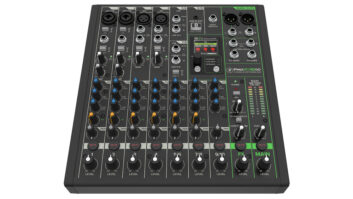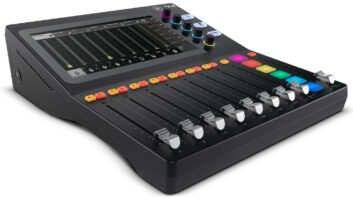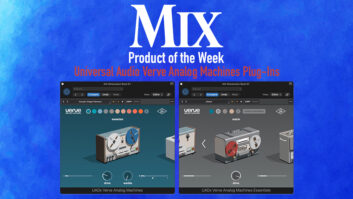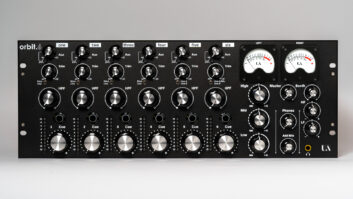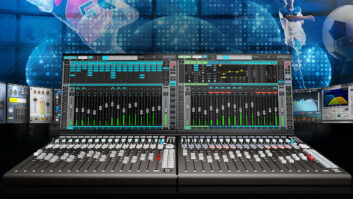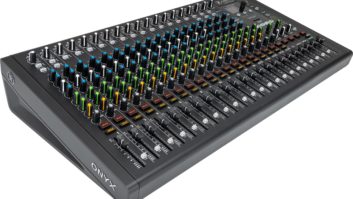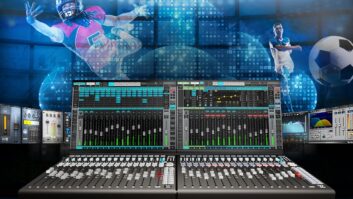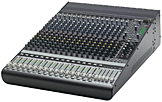
Mackie’s VLZ mixer set the standard in desktop consoles for a generation of studio engineers and live musicians. In 2004, Mackie introduced a new generation of compact mixers designed as a step-up to its VLZ Pro family. The new Mackie Onyx mixers offer improvements on hallmark Mackie technologies in addition to new ones designed to bring analog mixing into the high-resolution digital fast lane.
Reviewed here is the flagship Onyx 1640, which like the ubiquitous 1604 VLZ Pro, is a 16×4×2 mixer with six aux sends and a host of features — new and old.
POWERFUL, CLEAN PREAMPS
The 1640 comes with 16 great-sounding redesigned mic pre’s that would cost much more if purchased separately or in pairs. The preamps have a 123dB total dynamic range, -129.5dBm EIN and 0.0007-percent THD. The input trims work a little differently than the VLZ line, as it is designed for more real-world gain settings, handling from +22dB line-level down to micro-volt-level signals from a ribbon mic without adding noise.
I found that concept hard to believe until I tried them with every microphone I could get my hands on during the past two to three months. They really don’t add anything in terms of system noise, with plenty of usable gain. Even with a half-dozen open mics in a typical concert hall setting, the results were amazingly quiet. A Royer SF-12 ribbon mic delivered superb results with these preamps, as did my trusty B&K 4006s and a host of other large- and small-diaphragm mics. As a longtime VLZ Pro mic preamp user, I found the pre’s worth the upgrade cost alone — they are the cleanest, smoothest and quietest you’ll find just about anywhere at this price.
A 48-volt phantom power on/off switch (with its friendly bright green LED) is provided for each XLR input, something I’ve wanted for a long time. Occasionally, we all have to run something odd or unorthodox into those XLR jacks (in spite of the ¼-inch line-in jacks provided), so it’s very comforting to see, at a glance, which inputs have phantom power present and which don’t.
I/O ENHANCEMENTS
There’s no longer any need to use the TRS insert jacks as feeds to external recorders; Mackie has added two DB-25 connectors — eight balanced channels for each — to easily connect to the device of your choice. Twelve channels are featured on the 1220, and 16 channels on the 1620 and 1640. These balanced direct outputs are post-channel gain, but pre-EQ, pre-insert and pre-fader, giving you all the flexibility of individual tracking without using unbalanced partial insert plugs. The first two channels also have switchable hi-Z inputs for acoustic guitar pickups and other devices without a direct box — a bonus for anyone who regularly uses these things.
IMPROVED EQ, AUXES AND MORE
Moving past the standard low-end (75Hz) cut switches down to the EQ section, Mackie has provided another much-requested feature: true hardwire EQ bypass switches, useful for audiophiles on a budget. (There are times when no EQ is good EQ.) Still, the Cal Perkins-designed EQ section is another big improvement over the old VLZ EQ. There’s more info on this at www.mackie.com, but the stated goal was to use the classic “British” approach, which offers a smooth musical sound and adds greater boost/cut (±15dB) capabilities to make it suitable for a wider range of applications.
Six knobs provide ±15dB control at 12k (high), four controls for high-mid (400 Hz to 8k Hz) and low-mid (100 Hz to 2k Hz) pots, with a frequency select pot for each. Down at the low end is an 80Hz control that works with the low-cut switch, allowing for bass boost without low-end gunk. Specs tout minimum phase shift, making the entire EQ section more musical. I did find it to be a more traditional, usable EQ section, especially compared to the old VLZs, when I had to use it at all. It’s highly flexible when in and with the defeat switch, and completely invisible when out.
Further down the channel strip is the revamped aux section, which is now below the EQ. The 1640 features six discrete aux sends with individual pre/post switches and solo control. There’s a dedicated adjustable master control for each, which is useful for monitors, effects, video feeds and more. (The Onyx 1220 offers two aux sends, while the 1620 has four.)
Rounding out the channel strip is the constant loudness pan pot, mute switch, channel fader (60mm linear taper) and four signal level LEDs. More functional than the old “activity” LEDs, you now have 20, 0, +10 and OL (overload) to show if things are too hot.
Below the channel fader is a Solo button, which is now at the very bottom where I think it belongs. You get an instant feel for this configuration, quickly finding channels and Solo buttons as needed. It’s a simple but huge improvement from the old, tiny Solo button hiding among the sub-assigns.
Onyx mixers now sport a dedicated Talkback section with a built-in mic and a separate XLR jack for an external mic. You no longer need to tie up an input channel for a talkback mic. There’s a spring-loaded Talkback button, and the talkback signal can be routed to the control room/phones output to aux 1/2 or both.
Mackie confirms that the new “Planet Earth” power supply will allow Onyx mixers to work anywhere in the world. The 1640 ships with 220V and 110V IEC power cables — a real rarity these days as most printers don’t even come with their own USB cables.
FIREWIRE OPTION
The real buzz with this mixer is the FireWire card (sold separately). It is another huge step up for location recordists, sending 16 channels of digital audio (and another stereo mix from the L/R bus) at 24/96 to the computer platform and software of your choice. Whether on the road or in a project studio, the card is an easy way to track right out of the preamps to a digital recorder. Mackie includes its Traktion software (bundled free with the FireWire card; stand-alone retails for $80) on the driver CD-ROM. Installation was a breeze using two screws and one edge-connector cable.
You can monitor a two-mix out of the computer via the FireWire card back into the 1640 via the control room/phones source panel, choosing among main mix, tape, subs 1-2, 3-4 and FireWire option.
Probably the only issue that Mackie has yet to address is limiting the FireWire sends to pre-EQ and pre-fader. I’d suggest a user-changeable upgrade for the card to get around this.
PRO-LEVEL POWER
Mackie has truly addressed the needs of the pro user with Onyx’s many new features. The new preamps, redesigned surface, digital output and individual phantom power buttons puts this mixer head and shoulders above its predecessors. Other than the FireWire card limitations mentioned above, there’s not much else you’d need to add to this no-compromise mixer with an AD/DA card option. Sweet!
MSRPs: Onyx 1640, $1,539; FireWire card, $449.
Mackie, 800/258-6883, www.mackie.com.
Joe Hannigan runs Weston Sound & Video in Philadelphia.
